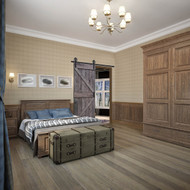A Guide to Interior Design Styles: American Colonial
Sep 22nd 2020
What could be more rustic and homey than American Colonial design? This design style began in the mid 1600s and continued through the end of the 1700s, falling to other styles once America shrugged off colony status and became its own country. Nevertheless, nostalgia for this style held sway. Several revival design periods cropped up in later years, highlighting the popularity of the American Colonial style.
American Colonial saw several adaptations in its time, but the overall design theme was of honesty, humble elegance, and handmade furniture pieces. We love this about American Colonial design — how the style incorporated new features as trends changed but never lost its resourceful spirit.
Designing your home with American Colonial charm means putting the focus on earthy colors, rustic but attractive furniture, unfussy walls and floors, and plenty of handcrafted textiles and ceramics.
Natural Color at Its BestTo the colonial Americans, color came from whatever they found in nature. This is why the style had warmth and earthiness at its core. Colonial colors weren't dull, though. To make diverse, attractive colors, they used pigments from plants, soil, minerals, chalk, sand, and other compounds, mixing them with binders for unique tones.
American Colonial colors included warm hues like yellow ochre, red ochre, burnt orange, dark brown, tan, creamy white, pale green, and varying shades of reds and pinks. Wealthier homes also had pigments like Prussian blue, vermilion, or indigo.
We love how these colors radiate comfort and make you feel at home the instant you walk indoors. To bring out the best in American Colonial colors, keep things simple. Early Colonial homes used about one to three colors across the home. You could add a pale yellow to the walls and complement it with a rusty red and chocolate brown area rug or hall runner. You could also add cushions, quilts, or decorative ceramics with hints of green, cream, or warm orange.
Wooden Floors and FurnitureHardwood floors were a staple in American Colonial homes, so it's important to pay homage to the skilled homebuilders of the past. Species like cherry, elm, maple, hickory, oak, walnut, and beech were in abundant supply around the colonies. Homes used a variety of wide planks, typically rough-sawn and unfinished. Most homes didn't use any type of stain or varnish on the floorboards, so the floors developed their own smooth texture with foot traffic use.
One of our favorite design details from this style is how common it became to see decorated floors. Here, homeowners in the early to mid 1700s often painted geometric and checkerboard designs on their plank flooring, or else used one color for the entire floor of a room.
As with floors, furniture was proudly handmade of wood and designed to last. American Colonial furniture was rustic, but it wasn't plain. In fact, many pieces had attractive motifs like flowers, scrolls, or leaves. They also had a variety of decorative carvings, tapered notching, finials, or raised panels.
Antique stores and skilled woodworkers could be an excellent starting place to source out American-made pieces. You can also look for reproductions that bring your home's interior design back to this nostalgic period.
Brightness with Unadorned WallsUnadorned walls in the American Colonial style have their own natural beauty. Typically, homes in this period had paneled or plastered walls, with lime wash brightening the space for a whitewashed look. Wealthier homes had a limited amount of papered walls above the wainscoting.
To achieve the ideal walls, try painting them in a soft cream or a muted green. You could also install and paint wood paneling and leave the upper part of the wall creamy white. As you add color, though, don't go overboard. American Colonial style is elegant in its simplicity, where dark wood furniture makes a statement against simple walls and complements soft, flowing curtains and fabric floor coverings.
You can also play with lighting that has intriguing wood or metal designs. Common lighting at the time included pewter or tin lanterns, carved wood and brass chandeliers, wrought iron sconces, and other hanging fixtures.
Handcrafts for PersonalityIn American Colonial design, handcrafts were what set your home apart from that of your neighbors. Quilting was popular and quilted fabrics covered all the beds in the home. Many fabrics were homespun from materials like hemp, wool, linen, and cotton, although imported European fabrics and toile patterns made an appearance on formal occasions.
To create Colonial interior designs, focus on all manners of soft furnishings, from bed covers to curtains, cushions, and throws. You can also include a variety of decor like woven baskets, wooden bowls, hand-carved figurines, stoneware, and American redware. Artwork like portraits, landscapes, or botanical prints can give your walls just the right touch. We recommend that you keep the artwork limited to just a few pieces per room.
We think that American Colonial interior design has much to admire. If you're looking for something else to finish the look, consider one of our classic sliding barn doors. We love the way that both the Plank Barn Door and the Double Z Barn Door complement this style perfectly.
